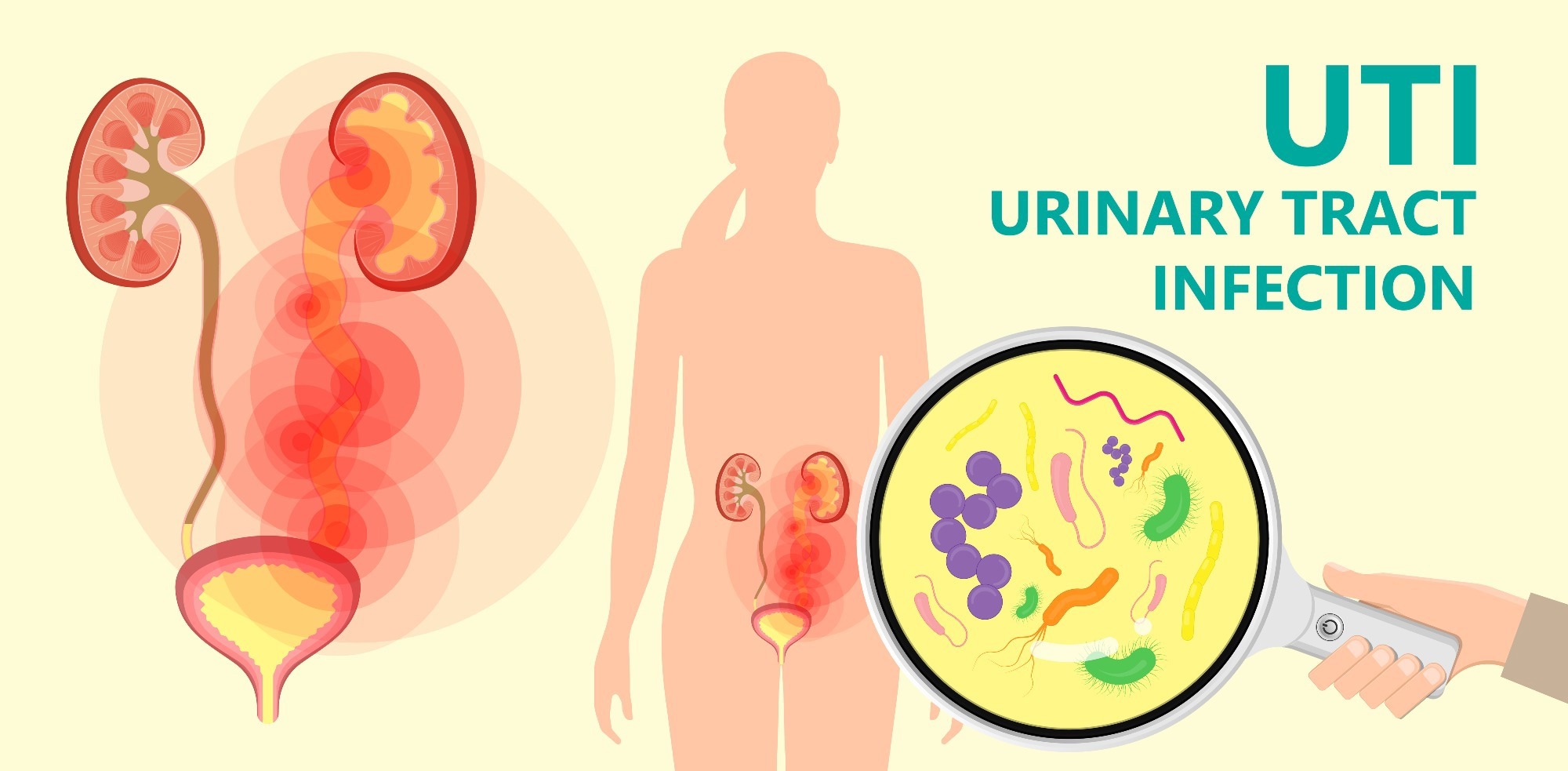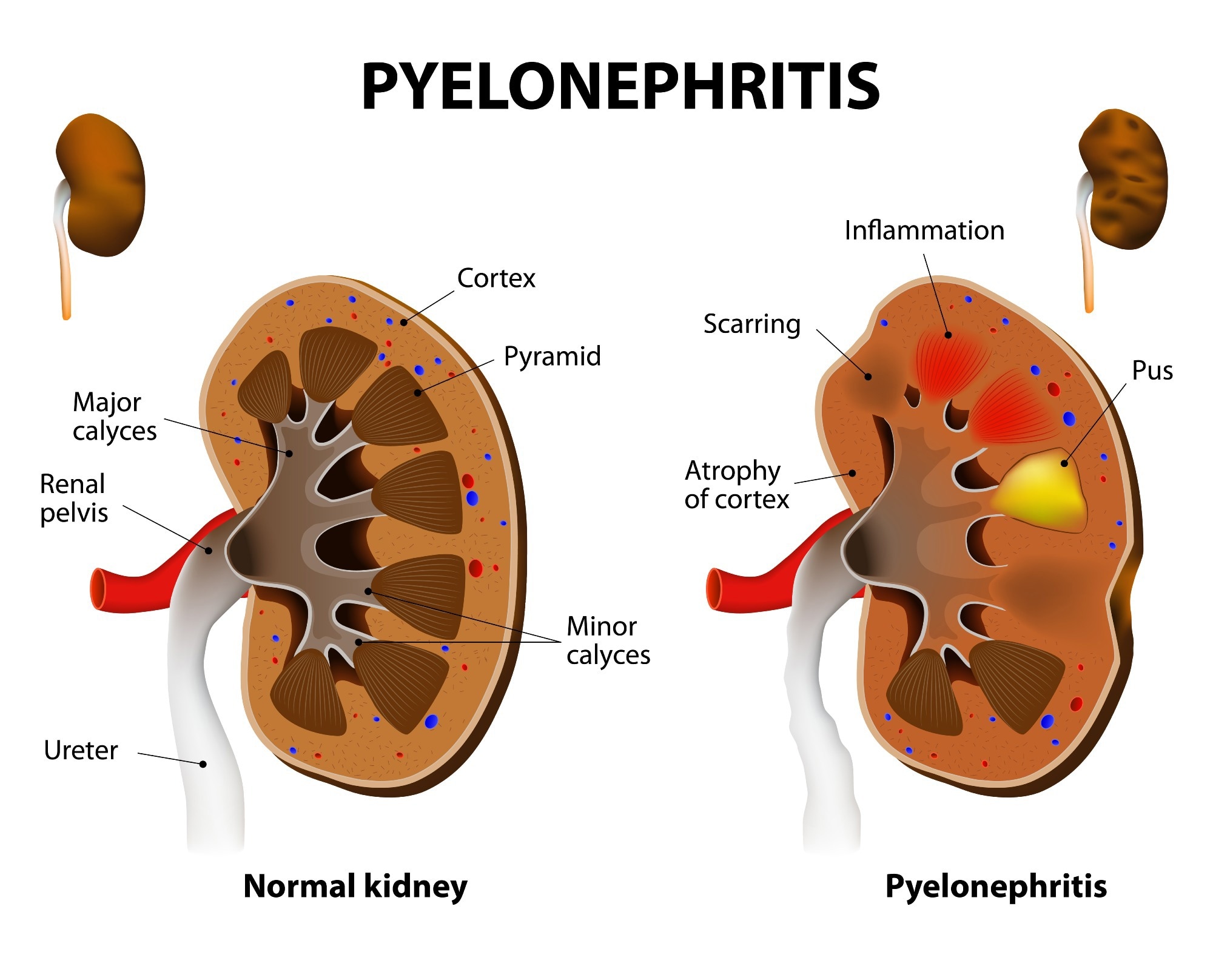Introduction to Urinary Tract Infections
UTIs In Men
UTIs In Women
Lower Urinary Tract (Bladder) Infection
Upper Urinary Tract (Kidney) Infection
UTIs in Young Children
UTIs in Elderly People
References
Further reading
Introduction to Urinary Tract Infections
It is important to identify signs and symptoms indicative of a urinary tract infection (UTI) to aid in the early diagnosis and timely treatment of the condition. Unfortunately, signs and symptoms of UTI are often subtle and might be overlooked, especially in the elderly. However, since UTIs can affect anyone of any age, it is what to look for:
- Frequent passing of small amounts of urine
- A persistent urge to urinate
- Burning sensation while urinating
- Cloudy and strong-smelling urine
- Passing red, pink, or cola-colored urine — indicates blood in the urine
- Women experience pelvic pain, especially in the center of the pelvis and around the pubic bone
The severity of the symptoms depends on whether it affects the upper or lower part of the urinary tract, the kidneys, or the bladder. In addition, some specific populations, such as the very young and elderly, have typical signs that can help to identify the infection.
 Image Credit: Pepermpron / Shutterstock
Image Credit: Pepermpron / Shutterstock
UTIs In Men
UTI is rare in young men; however, it does occur in older men past the age of 50, but they remain asymptomatic. It infects all or some parts of their urinary tract, including kidneys, ureters, bladder, urethra, and the prostate gland. Since the male urethra is long, it is difficult for bacteria to spread to the bladder and cause UTIs.
However, it might occur due to a sexually transmitted disease or if a stone in the urinary tract blocks the urine flow. An enlarged prostate can cause a UTI in older men by keeping urine from draining out of the bladder completely. It might also occur due to a catheter used to empty the bladder or urethral stricture, a narrowing of the urethra by scar tissue from previous infections or surgical procedures. In rare cases, bladder outlet obstruction from prostatic enlargement or stricture disease in men weakens their natural immunity making them more susceptible to contracting lower UTIs. Diabetes or other conditions that weaken the immune system make men prone to contracting a UTI. The symptoms of UTI in men may include:
- Urge to urinate more often and unable to contain it
- Burning sensation during urination
- Abdominal pain
- Penile discharge (clear fluid or pus)
- Fever or chills
- Reddish or cloudy urine
- Back pain due to infection in the prostate or kidney
In most cases, UTI symptoms do not last long once (more than 24 hours) after initiating the treatment. However, one should take the full course of medication to prevent the revival of infection. Without treatment, the infection can last a long time and, if left untreated, could permanently damage the bladder and kidneys. If it spreads to the blood, it can even be fatal. Moreover, older men should check their bladder outlet obstruction and residual urine volume post-voiding.
UTIs In Women
Women are more prone to contracting UTIs, almost 30 times more often than men; subsequently, over 50% of women contract at least one UTI in a lifetime. Moreover, women suffer from recurrent UTIs; thus, four of 10 women who get a UTI will get infected at least one more time within six months. These cases of recurrent infection require an ultrasound of the urinary tract to check for upper tract abnormalities and urinary stones. In addition, these women should take an adequate course of antibiotics and repeat urine microscopy, culture, and susceptibility tests after treatment is completed to ensure clearance of the organism. In women, if recurrence is associated with sexual activity, they should empty their bladder immediately after sex.
A women's bladder is most commonly affected during UTI because a woman's urethra is shorter than a man's and is closer to both vagina and anus, the primary source of UTI-causing bacteria, such as Escherichia coli (E. coli).
The symptoms of UTI in women are the same as in men, except that some older women might feel tired, confused, or weak. Also, blood in the urine is more common in younger women than in older women.
Women are at higher risk of developing a UTI due to multiple reasons. Sexual activity moves bacteria from the vagina to a woman's urethra, causing UTIs. Some sexually-active women also use spermicides that kill good bacteria in the urinary tract, making them prone to UTIs. In pregnant women, pregnancy hormones change the bacteria in the urinary tract. Also, they are unable to completely empty their bladders because the uterus with the developing baby sits on top of the bladder during pregnancy and that leftover urine causes UTIs.
Menopausal women have dry and thin vaginas due to loss of the hormone estrogen, facilitating bacteria growth in the urinary tract that can cause UTIs. Having diabetes and a kidney stone (like men) also makes women susceptible to contracting a UTI. In rare cases, women suffer from bacterial colonization and a UTI due to an indwelling catheter placed during surgery to drain urine when passing urine naturally is unfeasible. Lastly, hypo-oestrogenic states, such as atrophic vaginitis in women, weaken the body's natural defense mechanisms making women prone to UTIs.
Lower Urinary Tract (Bladder) Infection
An infection of the lower urinary tract is the most common type in the community and hospitals. Also, women are more prone to lower UTIs than men. Bladder infections generally present as cystitis, an inflammation or infection of the superficial bladder mucosa. Sometimes, lower UTI involves the urethra, the tube that leads from the bladder, enabling urine to exit the body, a condition referred to as urethritis. Characteristic symptoms of a bladder infection include:
- Frequent urination but passing small volumes of urine each time
- Dysuria
- Discolored urine, cloudy or bloody
- Strong offensive odor from urine
- Pain or burning upon urination
- Cramping in the lower abdominal region
- Non-specific lower back pain
- A general feeling of being unwell
- Low fever
- Loin pain accompanied by rigors, nausea and vomiting suggests an ascending infection
Nearly 80 to 90% of bladder infections are caused by Escherichia coli (E. coli), a pathogenic bacterium that ascends into the urinary tract via the urethra. Among others, Staphylococcus saprophyticus causes 5% to 10% lower UTIs. Additionally, enterococci species, Proteus mirabilis, and Klebsiella cause UTIs. In rare cases, UTI-causing bacteria spread from a hematogenous source and involves microorganisms, such as Staphylococcus aureus, Salmonella spp., and Mycobacterium tuberculosis. In such cases, and if the patient has signs of sepsis, doctors advise taking blood cultures.
 Nearly 80 to 90% of bladder infections are caused by Escherichia coli. Image Credit: Kateryna Kon / Shutterstock
Nearly 80 to 90% of bladder infections are caused by Escherichia coli. Image Credit: Kateryna Kon / Shutterstock
Management of uncomplicated acute bladder infections is relatively simple and involves antibiotic treatment for three to five days. In such cases, a physical examination reveals no structural or functional abnormalities within the urinary tract. The initial physical examination also includes checking vital signs, abdominal and flank examination. In men, the external genital examination may show phimosis or meatal stenosis and atrophic vaginitis in women. However, complicated UTIs require further evaluation because unless their cause is confirmed, the best treatment is often challenging to prescribe. In addition, lower UTIs are easier to diagnose using a urine dipstick (e.g., for nitrites).
Furthermore, there is progressive development of antimicrobial resistance to common antibiotics. For instance, antibiotic-resistant E. coli are becoming common in China and the Indian subcontinent. Up to 80% of such E. coli strains have a widespread presence in the elderly in long-term care facilities. Therefore, antibiotic choice should be guided by knowledge of local resistance patterns rather than empirical antibiotics.
If the infection goes untreated, the UTI-causing bacteria can spread to the kidneys in the upper urinary tract.
Upper Urinary Tract (Kidney) Infection
The symptoms of UTI are usually more severe when the kidneys are involved, which is also known as pyelonephritis or pyelo. Sometimes, upper UTIs in the kidneys spread to the tubes which carry urine from the kidney to the bladder, known as ureters. In addition to the symptoms associated with the bladder infection, symptoms of pyelonephritis may include:
- High fever
- Chills, shaking, and night sweats
- Fatigue
- Severe lower back pain,
- Pain in the side, back of the groin
- Confusion and mental state changes
- Nausea and vomiting
Pyelonephritis due to an obstructing ureteric stone is a medical emergency. These patients require immediate surgical drainage with the placement of a nephrostomy tube or ureteric stenting. In fact, all patients with complicated UTIs need an adequate course of antibiotics for at least 10 to 14 days.
 Pyelonephritis. Image Credit: Designua / Shutterstock
Pyelonephritis. Image Credit: Designua / Shutterstock
UTIs in Young Children
Infants and young children tend to be affected by more serious UTIs, and it is, therefore, important that parents could recognize early signs to seek medical help promptly to prevent possible complications. Symptoms of a UTI in young children may include:
- Persistent high fever without a known cause
- Problems feeding
- Signs of weakness
- Foul-smelling urine that is cloudy in color
- Frequent urination marked by bedwetting or poor daytime urine control
- Abdominal pain
UTIs in Elderly People
It is often difficult to recognize when an older adult has a UTI, as they may not be able to communicate early symptoms effectively. In some cases, the first or the only indicative sign of UTI in an older adult is the confusion, agitation, and change in the mental state associated with a severe upper UTI.
References
Further Reading
Last Updated: Sep 1, 2022